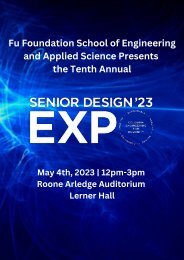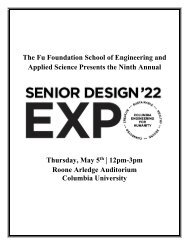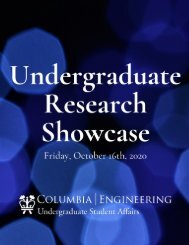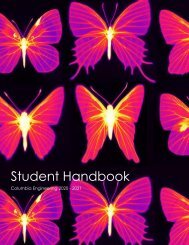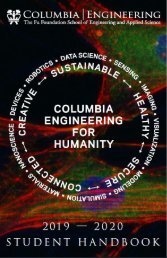Senior Design Expo 2019
The Senior Design Expo, held annually in May at Columbia University, is an opportunity for Columbia Engineering students to showcase what they have learned in their foundational math and science courses together with their engineering courses in innovative, creative, and purposeful designs and prototypes. Each year the Expo showcases more than 60 projects across all nine departments. Projects have included cutting-edge robotics, the New York City subway system, language technology, proposals for bridges to span the Hudson river, and much more.
The Senior Design Expo, held annually in May at Columbia University, is an opportunity for Columbia Engineering students to showcase what they have learned in their foundational math and science courses together with their engineering courses in innovative, creative, and purposeful designs and prototypes. Each year the Expo showcases more than 60 projects across all nine departments. Projects have included cutting-edge robotics, the New York City subway system, language technology, proposals for bridges to span the Hudson river, and much more.
Create successful ePaper yourself
Turn your PDF publications into a flip-book with our unique Google optimized e-Paper software.
Fueled by the Elements: A Solar-Powered Resort<br />
Bailey Alexander, Samantha Grech, Tracy Paltoo, Carly Press, Abigail Thomas<br />
Advisor: Tom Panayotidi<br />
This semester-long project aimed to design a solar-powered, locally oriented and socially<br />
conscious, storm-resilient resort on this northern coast of Puerto Rico in the Quebradillas region.<br />
<strong>Design</strong> of the 6-story eco-resort was approached from four civil engineering disciplines:<br />
Geotechnical Engineering, Structural <strong>Design</strong>, Environmental & Water Management, and<br />
Construction Management. The geotechnical engineering portion consisted of a literature-based<br />
analysis of the site’s soil conditions and design of the foundation. Subsurface site conditions were<br />
assumed to be 5 meters of alluvium resting on limestone bedrock, for which a mat foundation was<br />
optimal. The mat foundation was analyzed using SAP2000. Structural design included dead, live,<br />
wind, rain, earthquake, and flood load calculations, from which the load bearing members were<br />
designed. These members were floor slabs, beams, girders, and columns. The structure was<br />
visualized in AutoCAD and analyzed using SAP2000. For critical members, the SAP2000 results<br />
were checked against hand calculations. Environmental considerations centered on solar energy<br />
and water reuse, incorporating LEED design concepts where ever possible. The minimum<br />
photovoltaic capacity and requisite solar cell infrastructure were calculated for solar power design.<br />
Stormwater routing analysis was performed for a 100-year, 1-hour storm to design the roof<br />
drainage and calculate more accurate rain loads, while a 1-year, 12-hour storm was used to plan<br />
the greywater recycling system. After design, project implementation was outlined by the<br />
construction management team. Overall costs were estimated and key construction methods, such<br />
as monolithic construction, were designated. Scheduling was laid out through a work breakdown<br />
schedule, network diagram, and Gantt Chart. The final result is an environmentally conscious,<br />
cast-in-place reinforced concrete building.<br />
Keywords:<br />
<strong>Design</strong>, engineering, geotechnical, structural, water, environmental, construction, SAP2000,<br />
solar-powered, resort, concrete, cast-in-place, monolithic construction, Puerto Rico, civil<br />
engineering, gray water recycling<br />
26



